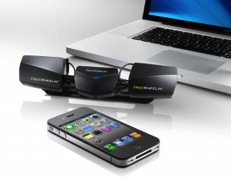Podcast: Play in new window | Embed
Tech News & Commentary
Jim in Oceano, California listening on KTIP 1450 “Talk is Power” and asked: “Is there any way I can have whatever is on my computer show up on my wall mounted TV?”
Yes there is but it depends on your TV and your computer. If both your TV and your computer are fairly modern, then they will both most likely have an HDMI port.
If that’s the case, all you need is an HDMI cable, which you can find for prices ranging from like $1 online to $100 at places like Radio Shack. Feel free to go cheap, it won’t make a huge difference. Once you plug it in to both devices, it should just work right away.
You’ll typically have 2 options for how things are displayed on your TV: either your screen will be “mirrored” — in which case everything that happens on your computer will be on the TV as well; or, it will be set to “extended desktop” in which case you basically get a long desktop, part of it will be on your computer and part of it will be on your TV and you should be able to drag things from one to the other.
For more information tune in to Hour 2 of our podcast.
“This Week in Tech History” Weekly Feature with Chris Graveline
Brian in Cleveland, Ohio listening on CKLW 800 asked: “I’ve noticed that the phones I purchased over the last few years have a lot of apps already installed on them that keep running in the background and cannot be deleted from the phone – at least not by any means I’ve tried. Is there a way to remove all these apps that were already on the phone when I bought it… or is there a phone I can buy, Android or iPhone, that will not come pre-loaded with all this garbage that eats up system resources?”
The easiest way to find an Android phone that doesn’t come with extra bloatware is to look for one with the word “Nexus” in the name. Nexus phones and “Google Phones” run a stock version of the Android OS and they come without extra apps built in.
By the way, iPhones come free of carrier bloatware, because Apple just doesn’t allow it. It has to be only their stuff on it.
Both stock Android phones and iPhones will still come with software you won’t be able to un-install even if you don’t use it, and some of it will perform some functions in the background, though nothing on either operating system is as bad as the apps carriers add onto the phones they customize.
You can always just root a phone and remove the apps you don’t like that way, but that does come with a certain amount of risk, it’s legal, but it will void your warranty and in some cases it may even violate the terms and conditions of your cell phone service, so it may be easier and safer to just stick to the route you chose and look for a phone that doesn’t come with a lot of bloatware to begin with.
For more information tune in to Hour 2 of our podcast.
Ramon in Bahrain listening to us on the American Forces Network asked: “Hi Dave, I am in the Military serving in Bahrain. I listen to American Forces Network and make sure that I hear your program on a regular basis. It is nice to have AFN where I am serving and makes me feel closer to home. At times, when we have sand blowing, the reception is very weak and I have to wait until the weather changes. I have a question: Many times I see people
write things about other people on the social media. How can I find out the authenticity of the writer? Or rather ,how can I find out the real writer of the message on the net? Thanks for all you do guys to keep us happy in this part of the world.”
That’s a tough one. It depends on what messages you’re really talking about. If this is something political, then to get the definite source. You may have to go to a site like LexisNexis, but it’s definitely gonna cost you.
If you want to try something simpler and cheaper, you can just Google it and try to find either reliable source naming the author, or see who is credited with the message the more.
If you want to check for veracity, you can try Snopes.com or Politifact.com. Both try to analyze the truth in statements and myths.
Since you mentioned social media as being the source of the message, you could always just ask them to cite their sources. Just try to ask nicely and explain that you’re actually interested in reading more and not just picking a fight.
For more information tune in to Hour 2 of our podcast.
Guests in this hour:
Joe Marrapodi, CEO – Greentoe
Want to name and pay your price on consumer electronics? Greentoe is an eCommerce company that enables you to name the price of what you want to pay on items like cameras, TVs, home audio and other products.
PRODUCT SPOTLIGHT with Rob: FreeWheelin Audio System
 FreeWheelin is a small speaker system that we find practical for cyclists, drivers and even office workers. It’s a triple threat: it’s an audio system designed for helmets, vehicles and desktops.
FreeWheelin is a small speaker system that we find practical for cyclists, drivers and even office workers. It’s a triple threat: it’s an audio system designed for helmets, vehicles and desktops.
It works with pretty much any portable music player. Can play your music via Bluetooth after you pair your device with it; or, you can use the headphone cable provided in the kit to connect your device. If you go the Bluetooth route and pair your smartphone, it can work as a handsfree speakerphone. There are buttons on the unit itself you can use to easily answer or reject calls. And, they can also be used to control your music.
If you use a helmet at work (like a construction worker for example) or you like to ride your bike, your safety may be put in jeopardy by wearing ear buds. It keeps you from hearing warning sounds around you.
This audio system frees your ears and easily attaches to a helmet with a dual-lock system – it’s pretty much like Velcro 2.0. You apply these in 3 different areas on your helmet and attach the FreeWheelin. You can then wirelessly play your music and enjoy it safely.
The sound quality is pretty good for this small unit. But, keep in mind people around you may hear your music or  calls if you’re blasting it.
calls if you’re blasting it.
This audio system also works in your car. There’s a visor clip attachment in the kit. It attaches to the FreeWheelin with the dual lock pads. After you attach it, just insert the clip on your visor. You can now use it as your handsfree speakerphone in your car.
You can also use it inside your office or home and use it as your speaker system. You can listen to your music or use it for online calls, like with Skype. The unit has a built-in microphone that works pretty well.
The FreeWheelin audio system has a rechargeable battery. It can provide up to 15 hours of music playing or 10 hours of talk time. So you’ll get a good work-day out of it.
If you’re interested, this will cost you just under $150 online. We think the price is a bit steep, but for those that can get good use out of this, we recommended trying it.
Jerry in Nashville, Tennessee listening on WTN 99.7 FM asked: “Hi Dave! I would like to know the name of the selling site you featured on the 11/02 show. It was a site that has an iPhone app where you can sell items quick and free!”
The app you’re asking about is called OfferUp. The website is OfferUpNow.com.
The app is currently only offered for iOS devices. All you have to do is take a picture of something you want to sell. Then, promote it using OfferUp. It is instantly circulated to friends, followers, people nearby, people of similar interests, and local groups on the OfferUp app. You can also look for items on their website. Before you buy, you can contact the seller with any questions.
For more information tune in to Hour 2 of our podcast.
This Week’s Prizes for Our Listeners:
Magix: Copies of Music Maker 2013 – Create your own tunes! Even beginners can easily create music.
Microsoft: Copies of Microsoft Streets & Trips 2013 Software
Steve Nicholls: Copies of his book “Social Media in Business – Succeeding in the New Internet Revolution” – A guide to the understanding of social media’s business value.

